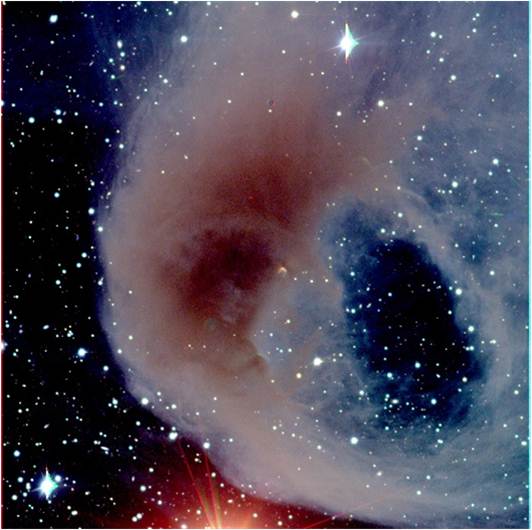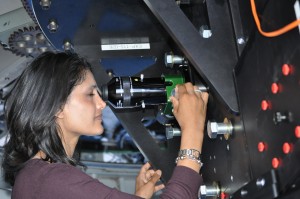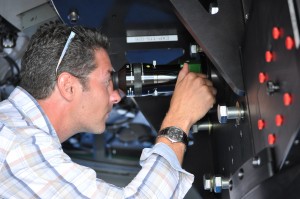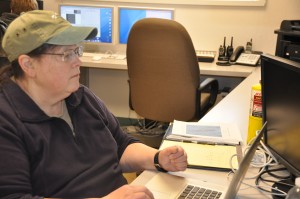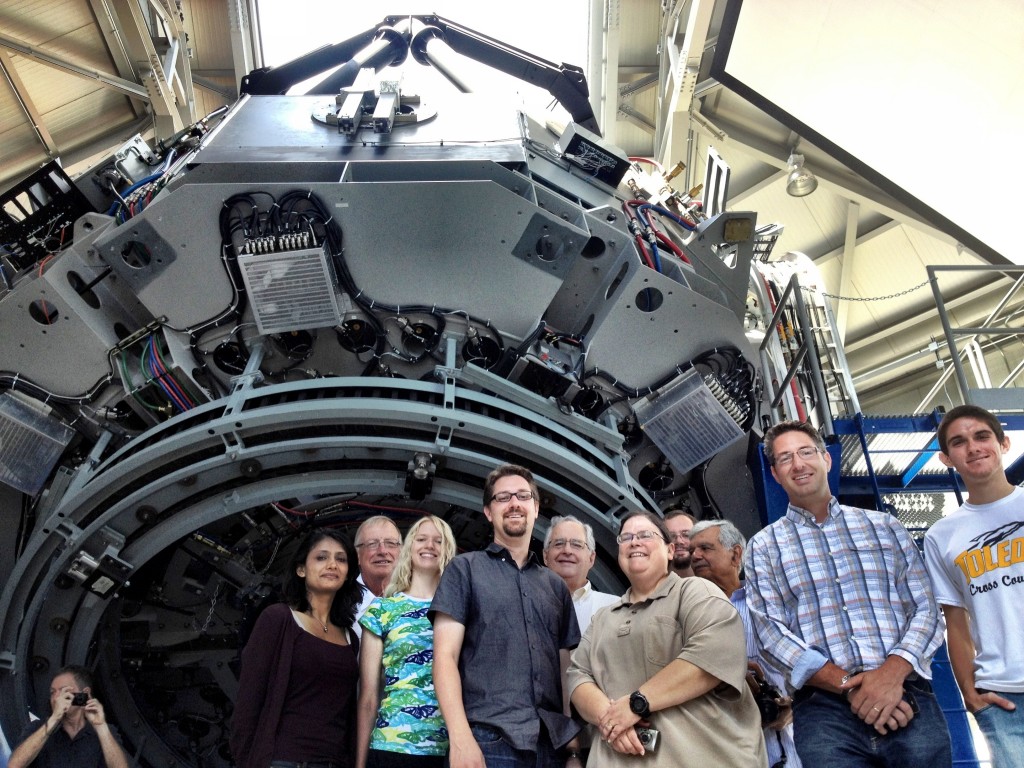Rocketing Into Space
by Patty Gelb
Rockets usually take people to space. But these UT Rockets are bringing space to you.
There are a lot of exciting initiatives happening around The University of Toledo. But potentially one of the most exciting is the new partnership between UT, the University of Maryland, Boston University, the Lowell Observatory and the Discovery Channel as a consortium utilizing the new Discovery Channel Telescope at Lowell Observatory.
“This really elevates our astronomy program to a level where we are competitive with the big boys,” stated Dr. Karen Bjorkman, the dean of the College of Natural Sciences and Mathematics. “Maybe not quite the biggest boys, but we are at least now on a field where a relatively small number of programs are, which is a very good thing for The University of Toledo.”
 Located in Happy Jack, Arizona, a little over 40 miles south of Flagstaff, the Discovery Channel Telescope is a 4.3-meter, state-of-the-art telescope that is the first of its kind. Often called the “swiss army knife” of telescopes, the Discovery Channel Telescope has an instrument bay that allows the user to change to any instrument they want within 30 seconds. This is an incredibly unique feature. Most telescopes have a lot of different instruments in their quiver. They can take big images, they can study the visual light we can see with our eyes and they can explore longer wave lengths or infrared light. But it can be a time consuming and physical task (sometimes 15 to 20 minutes or sometimes up to several hours) to change between each of the instruments. One of the special attributes of the Discovery Channel Telescope is it can simultaneously mount up to five of these instruments and can very rapidly switch between them just by moving a little mirror inside the apparatus. This is a very important attribute because it makes it very effective to follow rapidly evolving events.
Located in Happy Jack, Arizona, a little over 40 miles south of Flagstaff, the Discovery Channel Telescope is a 4.3-meter, state-of-the-art telescope that is the first of its kind. Often called the “swiss army knife” of telescopes, the Discovery Channel Telescope has an instrument bay that allows the user to change to any instrument they want within 30 seconds. This is an incredibly unique feature. Most telescopes have a lot of different instruments in their quiver. They can take big images, they can study the visual light we can see with our eyes and they can explore longer wave lengths or infrared light. But it can be a time consuming and physical task (sometimes 15 to 20 minutes or sometimes up to several hours) to change between each of the instruments. One of the special attributes of the Discovery Channel Telescope is it can simultaneously mount up to five of these instruments and can very rapidly switch between them just by moving a little mirror inside the apparatus. This is a very important attribute because it makes it very effective to follow rapidly evolving events.
“It may seem like the universe moves very slowly or even sits still and for many things that’s true,” said Dr. J.D. Smith, associate professor of astronomy. “But there are objects and events that happen in the universe, which develop over a time scale of hours, or even less. For example, there is a class of objects called gamma ray bursts, which are these incredible explosions, some of the biggest explosions in the universe. You don’t know that they are coming until you see one. When you spot one, you want to rapidly start following it and collecting data on it right away. So this capability to switch very quickly between different instruments is a real advantage that we will have with the Discovery Channel Telescope that just doesn’t exist in most places.”
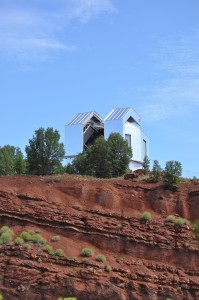 UT astronomers have been interested in partnering with a large telescope consortium for many, many years. Five years ago, Dr. Bjorkman was at a meeting with Dr. Jeffrey Hall, the current director of the Lowell Observatory. He was in discussions at that time with the Discovery Channel to try to build a large telescope and told her that he would keep UT in mind if that proceeded. A few years later she ran into him at the American Astronomical Society and he told her that they were moving ahead on the project. While Dr. Bjorkman expressed interest, she also said that at that time UT did not have the funding but to please keep her in mind. Two years ago Dr. Hall called her and said that they were looking for partners and asked if we were potentially interested. Dr. Bjorkman said that she was, but needed to look into it. Shortly after, she ran into UT President Dr. Lloyd Jacobs in an elevator and gave him a quick overview of the idea. He thought that the idea sounded interesting. Later in the year, Dr. Jacobs had a tenure interview with Dr. Smith. Dr. Smith spoke about the strong impact joining a large telescope consortium would have for the UT astronomy program. A few months later Dr. Bjorkman’s cell phone rang when she was at a meeting in Cleveland. It was Dr. Jacobs, who asked her to tell him the full details behind the concept of a telescope consortium. After hearing about it, he said that he was looking for projects that will help raise the profile of The University of Toledo. He knew that the astronomy program already had raised the profile, and that this project could take them to the next level. He asked Dr. Bjorkman to put together a proposal. Dr. Smith, with assistance from Dr. Rupali Chandar, associate professor of astronomy, worked directly with the Lowell Observatory to put together a proposal, and Dr. Bjorkman presented the full concept of the partnership to Dr. Jacobs, who in turn presented it to the UT Board of Trustees, and the project was approved to proceed in June 2012.
UT astronomers have been interested in partnering with a large telescope consortium for many, many years. Five years ago, Dr. Bjorkman was at a meeting with Dr. Jeffrey Hall, the current director of the Lowell Observatory. He was in discussions at that time with the Discovery Channel to try to build a large telescope and told her that he would keep UT in mind if that proceeded. A few years later she ran into him at the American Astronomical Society and he told her that they were moving ahead on the project. While Dr. Bjorkman expressed interest, she also said that at that time UT did not have the funding but to please keep her in mind. Two years ago Dr. Hall called her and said that they were looking for partners and asked if we were potentially interested. Dr. Bjorkman said that she was, but needed to look into it. Shortly after, she ran into UT President Dr. Lloyd Jacobs in an elevator and gave him a quick overview of the idea. He thought that the idea sounded interesting. Later in the year, Dr. Jacobs had a tenure interview with Dr. Smith. Dr. Smith spoke about the strong impact joining a large telescope consortium would have for the UT astronomy program. A few months later Dr. Bjorkman’s cell phone rang when she was at a meeting in Cleveland. It was Dr. Jacobs, who asked her to tell him the full details behind the concept of a telescope consortium. After hearing about it, he said that he was looking for projects that will help raise the profile of The University of Toledo. He knew that the astronomy program already had raised the profile, and that this project could take them to the next level. He asked Dr. Bjorkman to put together a proposal. Dr. Smith, with assistance from Dr. Rupali Chandar, associate professor of astronomy, worked directly with the Lowell Observatory to put together a proposal, and Dr. Bjorkman presented the full concept of the partnership to Dr. Jacobs, who in turn presented it to the UT Board of Trustees, and the project was approved to proceed in June 2012.
 What was approved was a 10-year commitment between UT and the Lowell Observatory making UT one of three key institutions (UT, Boston University and the University of Maryland) to join the Lowell Observatory and the Discovery Channel in a scientific partnership. This partnership grants dedicated telescope time at the institutional partners for the Discovery Channel Telescope. One of the difficulties in the world of astronomy is gaining observation time at a large telescope to conduct research. Generally, scientists compete with many other astronomers for a limited amount of observing time. With dedicated access, scientists can develop longer-term science projects with a broader scientific scope than what they would be able to do without it. Other telescope consortiums were considered during the decision process, but this partnership was the right match for UT.
What was approved was a 10-year commitment between UT and the Lowell Observatory making UT one of three key institutions (UT, Boston University and the University of Maryland) to join the Lowell Observatory and the Discovery Channel in a scientific partnership. This partnership grants dedicated telescope time at the institutional partners for the Discovery Channel Telescope. One of the difficulties in the world of astronomy is gaining observation time at a large telescope to conduct research. Generally, scientists compete with many other astronomers for a limited amount of observing time. With dedicated access, scientists can develop longer-term science projects with a broader scientific scope than what they would be able to do without it. Other telescope consortiums were considered during the decision process, but this partnership was the right match for UT.
“It was a brand new, state-of-the-art, really fantastic telescope with a proposed instrument suite that fit nicely with our research here at UT,” said Dr. Bjorkman. “So that was an attractive draw to us. But another attractive draw was Lowell Observatory and the Discovery Channel’s involvement. Lowell is an historic observatory. It is the place where Pluto was discovered. It is also where the first evidence of the expanding universe was discovered. So it has historical importance. But on top of that, it has a very definite mission that focuses not only on research, but also on education and outreach. With our tie-in of the newly renovated Ritter Planetarium and some of our own outreach efforts, we thought it was a natural match.”
The UT agreement allows students and researchers about 20 nights of dedicated observation time at the telescope. Every three months students and researchers develop short proposals that explain the project they want to explore, and how much telescope time they will need with which instruments. All proposals for telescope time start with Dr. Smith, who coordinates the UT activities for the Discovery Channel Telescope. These proposals then go in front of the UT telescope time allocation committee who review all of the proposals to decide how to allocate the time. It is a competitive process.
“Our agreement allots us roughly 20 nights of observing time per year, which we thought was about right for the size of our group. Different partners have different levels of time. For example, Boston University bought in at a much higher level so they get more time allocated. They have 35 astronomers and UT has eight. Because the telescope is so new, right now there is only one instrument on the telescope, the imager, which by the way is REALLY fantastic,” said Dr. Bjorkman. “The rest of the instruments should be up and running by sometime in 2014. That has limited the number of nights that we have needed initially because different astronomers need different capabilities like spectroscopy that aren’t quite ready yet. If we don’t use all of our nights that are allocated to us in the early years, we can bank them for use in later years, we don’t lose them.”
The research that UT scientists and students will conduct using the Discovery Channel Telescope at Lowell Observatory is fascinating. Dr. Bjorkman’s research interest is in disks around stars. Some stars have gas and dust disks around them and these disks in some cases can form solar systems. In other cases they are just part of the star’s natural evolution, and they sometimes come and go. What scientists don’t know is how often that happens, why it happens, or what the time scale is for these events. Dr. Bjorkman is interested in learning more about that time scale and about the physical things that are happening to build or destroy these disks. One problem with watching just one star for a long time is a scientist may or may not catch it doing this. A better way to catch more of these events is to study whole clusters of many stars. Studying clusters lets the scientist know they are all roughly the same age of star and they are roughly in the same part of their lifetime. Capturing multiple stars with variable disks gives benchmarks about where in a star’s lifetime this happens. It answers the questions, “Is it common, is it uncommon, what’s the timescale?” Dr. Bjorkman is doing cluster work looking at those types of issues. “I should point out that we are using our Ritter Observatory in conjunction with this because we can tie some of the work we are doing at Ritter with the work being done at the Discovery Channel Telescope, which is a better site and a bigger telescope. There are things we can’t do at Ritter, but there are some complementary things that we can do at Ritter that we don’t need the Discovery Channel Telescope for. So we can actually match them up nicely and we are doing some of that with this cluster work,” said Dr. Bjorkman.
 One project being worked on is high latitude galactic clouds. These are clouds of very cold gas and dust. If you picture that the galaxy is like a Frisbee, these clouds are way above or way below the plane of the Frisbee. Scientists don’t know how they got up there and don’t really know what the properties are of these cold gas clouds. UT astronomers and graduate students want to learn more about these clouds and have already obtained new data with the Discovery Channel Telescope to study them. They created a beautiful image of one of these clouds that reveals a solitary star forming right on its surface. A UT graduate student, Aditya Togi and UT professor emeritus Dr. Adolph Witt (who is still very active in the UT astronomy program) are trying to investigate this particular dark cloud.
One project being worked on is high latitude galactic clouds. These are clouds of very cold gas and dust. If you picture that the galaxy is like a Frisbee, these clouds are way above or way below the plane of the Frisbee. Scientists don’t know how they got up there and don’t really know what the properties are of these cold gas clouds. UT astronomers and graduate students want to learn more about these clouds and have already obtained new data with the Discovery Channel Telescope to study them. They created a beautiful image of one of these clouds that reveals a solitary star forming right on its surface. A UT graduate student, Aditya Togi and UT professor emeritus Dr. Adolph Witt (who is still very active in the UT astronomy program) are trying to investigate this particular dark cloud.
Another project of interest to UT astronomers like Dr. Will Fischer, a postdoctoral fellow, and Dr. Tom Megeath, associate professor of astronomy is studying very young stars. They are trying to determine the process by which these infant stars accrete matter and how they grow into “adult” stars. UT scientists are looking at baby stars embedded in a cloud that is the building blocks of material from which they were being formed; gas and dust. Some of gas and dust is still falling in, onto the star. They are using the telescope to study the nature of some of these things that are still imbedded in this cloud because it is difficult to see. They are pretty faint so the Discovery Channel Telescope is ideal for this type of study.
Other UT astronomers, like Dr. Chandar and her research group are studying and interested in the evolution of galaxies and how they change through time. Looking at galaxies very far away means you are looking at galaxies that are earlier in the life of the universe. This means by studying these far away galaxies, they can see how the universe changes over time.
There are UT astronomers such as Dr. Steve Federman, professor of astronomy and Dr. Witt, who are interested in the material between the stars and between the galaxies. They are looking at the properties of the gas and dust between the stars. They will be at the Discovery Channel Telescope to do that once the spectrographs come online.
Dr. Mike Cushing, assistant professor of astronomy is studying very cold stars that are called brown dwarfs. They are essentially failed stars that just didn’t get big enough to ignite into a star. Dr. Cushing is famous for discovering brown drawf stars that are so cool that if you could walk up to them, you could put your hand on them and not burn yourself. He is interested in following up on a number of these brown dwarfs which have been discovered by the Wide-Field Infrared Survey Explorer (WISE) which is a NASA space-based instrument. These are being followed up on from the ground to learn more about their properties.
Dr. J.D. Smith is working on nearby galaxies. These are galaxies out to a few million light years which may not sound terribly nearby. But, they are close enough that he can produce beautiful images and divide them up to their constituent regions. Doing that, Dr. Smith will look at what’s happening at the nucleus of the galaxy, where it is believed for most galaxies there is a very massive black hole. These black holes are maybe a million, or even a billion times the mass of the sun. They have a major impact on the host galaxy itself. With galaxies relatively nearby like this, Dr. Smith can actually divide these galaxies into different zones and regions. This allows him to explore this impact in terms of feedback, which is the reaction of the activity of the giant black hole on the rest of the galaxy.
As interested UT alumni and friends, we will be able to follow some of this research through Discovery Communication’s involvement. Their primary interest is in educational materials and programming for the Discovery Channel. They have been interested for a long time in the work that the Lowell Observatory has been doing and also in astronomy in general. The Discovery Channel saw this as an opportunity to support a program that would simultaneously support cutting-edge scientific research while also providing material for them to use in producing educational programming. Their interest is in publicizing the scientific results that come from the Discovery Channel Telescope at Lowell Observatory. They have already run one special called “Scanning the Skies”, which documents the building of the Discovery Channel Telescope. The Discovery Channel’s plan is to do periodic full-length programs about their telescope and the work that is going on there. They are also developing educational materials around the concepts of astronomy and science in general to take into the schools. The University of Toledo has a real interest in working with the Discovery Channel to help them develop educational programs using our own Ritter Planetarium and our own outreach and educational programs. Their main focus of educational programming, outreach and publicizing the work of the consortium scientists is to get people excited about science in general and astronomy in particular.
“We are hoping that in the future we can develop some of our own programming for Ritter Planetarium,” Bjorkman explains. “The Discovery Channel potentially could use these programs with school groups or we could sell them to other planetariums. The Ritter Planetarium is fully digital now. To build programming, you essentially have to warp images and videos so they project on the dome to become like a 3-D view. Our new computer system will actually allow us to develop our own programming. And we have been collaborating with the College of Communication and the Arts to make this happen. Some of the art professors and students have been working with our people at Ritter Planetarium to think about ways that we can combine science and art into educational materials that we can present at the planetarium.”
This wonderful consortium with the Discovery Channel Telescope, Lowell Observatory and partner universities really puts The University of Toledo on the national map in terms of its astronomy and astrophysics programs and people are starting to take notice. The quality of applications for UT graduate programs is getting better and better. Students from major universities all over the U.S. are expressing interest in coming to work with UT’s faculty and projects.
“So we now have the potential to do wonderful things with this telescope,” said Dr. Bjorkman. “We want to make sure that our students are directly connected to it. However, since we don’t have remote observing set up yet – that is planned for the future – we physically have to go to Arizona to use it. We really want to be able to have students go out there to have that hands-on experience, but the problem is that the travel is somewhat expensive. We would ultimately like to develop an endowed fund that could support student travel to go out there and fully participate in using the telescope. We want our students to develop scientific projects for the Discovery Channel Telescope. We want them to come up with the ideas for the project, thinking about the scientific questions that they need to ask, what physics they need to know, and then to go out there and collect the data, come back here with the data that they got and reduce and analyze the data. We want them to go from start to finish of the scientific process and hopefully go on to publish that data in a publication to share their discoveries with the world. We want them to experience the opportunity to contribute to the development of science. That’s the goal, that’s the big picture. Supporting that is going to be challenging, but is a very worthwhile goal.”
Dr. Smith and Dr. Bjorkman both shared a similar sentiment – astronomy has the power to engage and captivate the mind like no other field of science. As many hard questions are being asked about the role of the University, it took real vision on the part of President Jacobs and UT’s Board of Trustees to lift their gaze and see the deep, very human impact of exploring our universe with the Discovery Channel Telescope. They wanted to thank President Jacobs and the Board for taking this leap. “It may seem very remote in some ways, but in taking that leap, I think they are going to be delighted when they start to see it pay off,” shared Dr. Smith.
To view more photographs taken from the Discovery Channel Telescope, click here to visit the Lowell Observatory website gallery.
To watch the video “Stars in Alignment: UT Astronomy and the Discovery Channel Telescope: Click Here.
To watch a video of the first use of the Discovery Channel Telescope by UT astronomers: Click Here.


